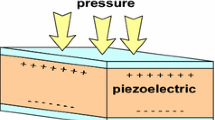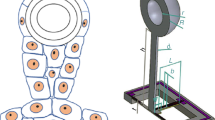Abstract
In the paper, a micromachined artificial vector hydrophone arises from a biological inspiration, the fish hair cell is presented. It is desirable that the application of piezoresistive effects combined with ingenious bionic structure and MEMS technology may improve the low-frequency sensitivity of the vector hydrophone as well as its miniaturization. Modeling processes for realizing the artificial hair cell hydrophone, along with preliminary characterization results in terms of sensitivity, frequency response and directivity patterns are also introduced. The microstructure of the sensor consists of four vertical cantilever beams with attached rigid plastic cylinder in the center of the structure. By locating eight piezoresistors logically formed the Wheatstone bridges; they can detect two components of underwater acoustic signal simultaneously. The prepared vector hydrophone has been measured in the standing wave field finally. The experiment results show that the vector hydrophone has good low-frequency characteristic, the free-field voltage sensitivity is −197.2 dB (0 dB = 1 V/μPa) at 400 Hz with a about 2 dB one-third octave positive slope over the 40–400 Hz bandwidth. The depth of pits of the directivity pattern is about 34.6 dB.















Similar content being viewed by others
References
Adams C (2000) The human system as a primary driver in long duration vehicle architecture. Life Support Biosph Sci 7(1):97
Albert JT, Friedrich OC, Denchant HE, Barth FG (2001) Arthropod touch reception: spider hair sensilla as rapid touch detectors. J Comp Physiol A 187:303–312
Baar JV, Dijkstra M, Wiegerink R, Lammerink T, Boer R de, Krijnen G (2005) Arrays of cricket-inspired sensory hairs with capacitive motion detection IEEE international conference on MEMS, Miami Beach
Chen J, Engel JM, Liu C (2003) Development of polymer-based artificial hair cell using surface micromachining and 3D assembly. In: 12th international conference on solid-state sensors, actuators, and microsystems, Boston
Coombs S (2001) Smart skins: information processing by lateral line flow sensors. Auton Robots 11:255–261
Dijkgraaf S (1963) The functioning and significance of the lateral-line organs. Biol Rev 38:51–105
Fan Z, Chen J, Zou J, Li J, Liu C, Delcomyn F (2002a) Development of artificial lateral-line flow sensors proceedings of the solidstate sensors and actuators workshop, Hilton Head Island
Fan Z, Chen J, Zou J, Bullen D, Liu C, Delcomyn F (2002b) Design and fabrication of artificial lateral-line flow sensors. J Micromech Microeng 12:655–61
Gad-El-Hak M (2002) The MEMS handbook. CRC Press, New York
Jielof R, Spoor A, Vries de H (1952) The microphonic activity of the lateral line. J Physiol 116:137–157
Kang K (2004) Development of an accelerometer-based underwater acoustic intensity sensor. J Acoust Soc Am 116(6):3384–3392
Moffett Mark BA (1998) Piezoelectric flexural-disk neutrally buoyant underwater accelerometer. J Acoust Soc Am 45:1346–1351
Leslie CB, Kendall JM, Jones IL (1956) Hydrophone for measuring particle velocity. J Acoust Soc Am 28(4):711–7155
Newnham RE (1992) Piezoelectric sensors and actuators smartmaterials. IEEE frequency control symposium, pp 513–24
Ozaki Y, Ohyama T, Yasuda T, Shimoyama I (2000) Air flow sensor modeled on wind receptor hairs of insects, presented at IEEE international conference on MEMS
Sand O (1981) The lateral line and sound reception. In: Tavolga WN, Popper AN, Fay RR (eds) Hearing and sound communication in fishes. Springer, New York, pp 459–80
Shchurov VA (1991) The interaction of energy flows of underwater ambient noise and local source. J Acoust Soc Am 90(4):1002–1004
Acknowledgments
This work was supported by the National Natural Science Foundation of China (Grant No. 50405025, 50535030) and Program for New Century Excellent Talents in University of China (NCET).
Author information
Authors and Affiliations
Corresponding author
Rights and permissions
About this article
Cite this article
Zhang, B., Qiao, H., Chen, S. et al. Modeling and characterization of a micromachined artificial hair cell vector hydrophone. Microsyst Technol 14, 821–828 (2008). https://doi.org/10.1007/s00542-008-0560-0
Received:
Accepted:
Published:
Issue Date:
DOI: https://doi.org/10.1007/s00542-008-0560-0




